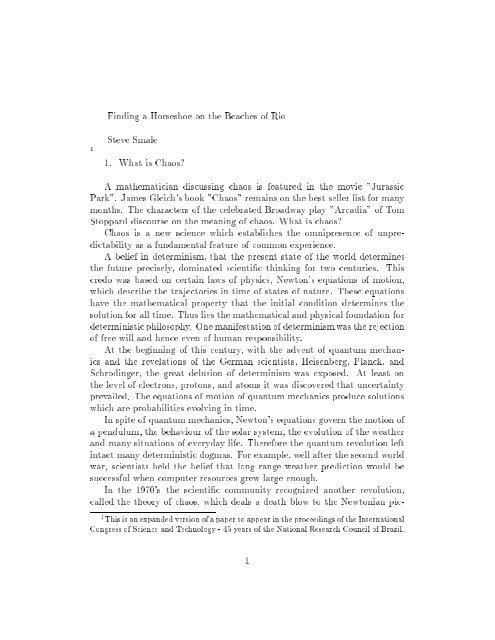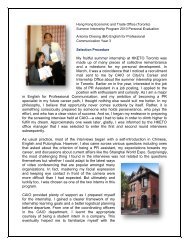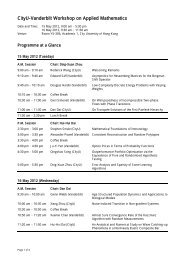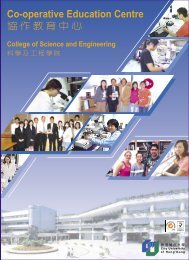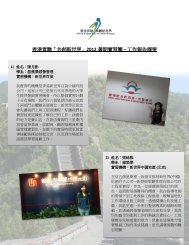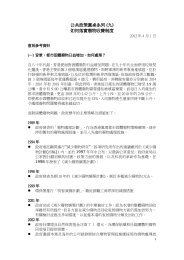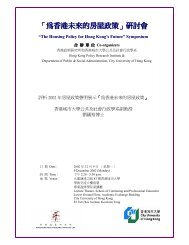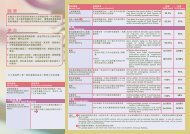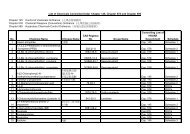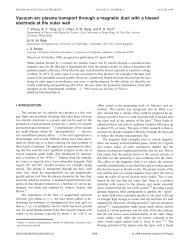Finding a Horseshoe on the Beaches of Rio Steve Smale 1. What is ...
Finding a Horseshoe on the Beaches of Rio Steve Smale 1. What is ...
Finding a Horseshoe on the Beaches of Rio Steve Smale 1. What is ...
Create successful ePaper yourself
Turn your PDF publications into a flip-book with our unique Google optimized e-Paper software.
1<br />
<str<strong>on</strong>g>Finding</str<strong>on</strong>g> a <str<strong>on</strong>g>Horseshoe</str<strong>on</strong>g> <strong>on</strong> <strong>the</strong> <strong>Beaches</strong> <strong>of</strong> <strong>Rio</strong><br />
<strong>Steve</strong> <strong>Smale</strong><br />
<strong>1.</strong> <strong>What</strong> <strong>is</strong> Chaos?<br />
A ma<strong>the</strong>matician d<strong>is</strong>cussing chaos <strong>is</strong> featured in <strong>the</strong> movie "Jurassic<br />
Park". James Gleich's book "Chaos" remains <strong>on</strong> <strong>the</strong> best seller l<strong>is</strong>t for many<br />
m<strong>on</strong>ths. The characters <strong>of</strong> <strong>the</strong> celebrated Broadway play "Arcadia" <strong>of</strong> Tom<br />
Stoppard d<strong>is</strong>course <strong>on</strong> <strong>the</strong> meaning <strong>of</strong> chaos. <strong>What</strong> <strong>is</strong> chaos?<br />
Chaos <strong>is</strong> a new science which establ<strong>is</strong>hes <strong>the</strong> omnipresence <strong>of</strong> unpredictability<br />
asafundamental feature <strong>of</strong> comm<strong>on</strong> experience.<br />
A belief in determin<strong>is</strong>m, that <strong>the</strong> present state <strong>of</strong> <strong>the</strong> world determines<br />
<strong>the</strong> future prec<strong>is</strong>ely, dominated scienti c thinking for two centuries. Th<strong>is</strong><br />
credo was based <strong>on</strong> certain laws <strong>of</strong> physics, Newt<strong>on</strong>'s equati<strong>on</strong>s <strong>of</strong> moti<strong>on</strong>,<br />
which describe <strong>the</strong> trajectories in time <strong>of</strong> states <strong>of</strong> nature. These equati<strong>on</strong>s<br />
have <strong>the</strong> ma<strong>the</strong>matical property that <strong>the</strong> initial c<strong>on</strong>diti<strong>on</strong> determines <strong>the</strong><br />
soluti<strong>on</strong> for all time. Thus lies <strong>the</strong> ma<strong>the</strong>matical and physical foundati<strong>on</strong> for<br />
determin<strong>is</strong>tic philosophy. One manifestati<strong>on</strong> <strong>of</strong> determin<strong>is</strong>m was <strong>the</strong> rejecti<strong>on</strong><br />
<strong>of</strong> free will and hence even <strong>of</strong> human resp<strong>on</strong>sibility.<br />
At <strong>the</strong> beginning <strong>of</strong> th<strong>is</strong> century, with <strong>the</strong> advent <strong>of</strong>quantum mechanics<br />
and <strong>the</strong> revelati<strong>on</strong>s <strong>of</strong> <strong>the</strong> German scient<strong>is</strong>ts, He<strong>is</strong>enberg, Planck, and<br />
Schrodinger, <strong>the</strong> great delusi<strong>on</strong> <strong>of</strong> determin<strong>is</strong>m was exposed. At least <strong>on</strong><br />
<strong>the</strong> level <strong>of</strong> electr<strong>on</strong>s, prot<strong>on</strong>s, and atoms it was d<strong>is</strong>covered that uncertainty<br />
prevailed. The equati<strong>on</strong>s <strong>of</strong> moti<strong>on</strong> <strong>of</strong> quantum mechanics produce soluti<strong>on</strong>s<br />
which are probabilities evolving in time.<br />
In spite <strong>of</strong> quantum mechanics, Newt<strong>on</strong>'s equati<strong>on</strong>s govern <strong>the</strong> moti<strong>on</strong> <strong>of</strong><br />
a pendulum, <strong>the</strong> behaviour <strong>of</strong> <strong>the</strong> solar system, <strong>the</strong> evoluti<strong>on</strong> <strong>of</strong> <strong>the</strong> wea<strong>the</strong>r<br />
and many situati<strong>on</strong>s <strong>of</strong> everyday life. Therefore <strong>the</strong> quantum revoluti<strong>on</strong> left<br />
intact many determin<strong>is</strong>tic dogmas. For example, well after <strong>the</strong> sec<strong>on</strong>d world<br />
war, scient<strong>is</strong>ts held <strong>the</strong> belief that l<strong>on</strong>g range wea<strong>the</strong>r predicti<strong>on</strong> would be<br />
successful when computer resources grew large enough.<br />
In <strong>the</strong> 1970's <strong>the</strong> scienti c community recognized ano<strong>the</strong>r revoluti<strong>on</strong>,<br />
called <strong>the</strong> <strong>the</strong>ory <strong>of</strong> chaos, which deals a death blow to <strong>the</strong> Newt<strong>on</strong>ian pic-<br />
1 Th<strong>is</strong> <strong>is</strong> an expanded versi<strong>on</strong> <strong>of</strong> a paper to appear in <strong>the</strong> proceedings <strong>of</strong> <strong>the</strong> Internati<strong>on</strong>al<br />
C<strong>on</strong>gress <strong>of</strong> Science and Technology-45years <strong>of</strong> <strong>the</strong> Nati<strong>on</strong>al Research Council <strong>of</strong> Brazil.<br />
1
ture <strong>of</strong> determin<strong>is</strong>m. As a c<strong>on</strong>sequence, <strong>the</strong> world now knows that <strong>on</strong>e must<br />
deal with unpredictability in understanding comm<strong>on</strong> experience. The coinipping<br />
syndrome <strong>is</strong> pervasive. "Sensitive dependence <strong>on</strong> initial c<strong>on</strong>diti<strong>on</strong>s"<br />
has become a catchword <strong>of</strong> modern science.<br />
Chaos c<strong>on</strong>tributes much more than extending <strong>the</strong> domain <strong>of</strong> indeterminancy,<br />
just as quantum mechanics did so more than half a century earlier.<br />
The deeper understanding <strong>of</strong> dynamics underlying <strong>the</strong> <strong>the</strong>ory <strong>of</strong> chaos has<br />
shed light <strong>on</strong>every branch <strong>of</strong> science. Its accompl<strong>is</strong>hments range from an<br />
analys<strong>is</strong> <strong>of</strong> electrocardiagrams to aiding <strong>the</strong> c<strong>on</strong>structi<strong>on</strong> <strong>of</strong> computati<strong>on</strong>al<br />
devices.<br />
Chaos developed not with <strong>the</strong> d<strong>is</strong>covery <strong>of</strong> new physical laws, but by a<br />
deeper analys<strong>is</strong> <strong>of</strong> <strong>the</strong> equati<strong>on</strong>s underlying Newt<strong>on</strong>ian physics. Chaos <strong>is</strong> a<br />
scienti c revoluti<strong>on</strong> based <strong>on</strong> ma<strong>the</strong>matics. Deducti<strong>on</strong> ra<strong>the</strong>r than inducti<strong>on</strong><br />
<strong>is</strong> <strong>the</strong> methodology. Chaos takes <strong>the</strong> equati<strong>on</strong>s <strong>of</strong> Newt<strong>on</strong>, analyses <strong>the</strong>m<br />
with ma<strong>the</strong>matics, and uses that analys<strong>is</strong> to establ<strong>is</strong>h <strong>the</strong> widespread unpredictability<br />
in <strong>the</strong> phenomena described by those equati<strong>on</strong>s. Via ma<strong>the</strong>matics,<br />
<strong>on</strong>e establ<strong>is</strong>hes <strong>the</strong> failure <strong>of</strong> Newt<strong>on</strong>ian determin<strong>is</strong>m by using Newt<strong>on</strong>'s own<br />
equati<strong>on</strong>s!<br />
2. Taxpayers M<strong>on</strong>ey<br />
In 1960 in <strong>Rio</strong> de Janeiro I was receiving support from <strong>the</strong> Nati<strong>on</strong>al Science<br />
Foundati<strong>on</strong> (NSF) <strong>of</strong> <strong>the</strong> United States as a postdoctoral fellow, while<br />
doing research in an area <strong>of</strong> ma<strong>the</strong>matics which was to become <strong>the</strong> <strong>the</strong>ory<br />
<strong>of</strong> chaos. Subsequently questi<strong>on</strong>s were ra<strong>is</strong>ed about my having used U.S.<br />
taxpayer's m<strong>on</strong>ey for th<strong>is</strong> research d<strong>on</strong>e <strong>on</strong> <strong>the</strong> beaches <strong>of</strong> <strong>Rio</strong>. In fact n<strong>on</strong>e<br />
o<strong>the</strong>r than President Johns<strong>on</strong>'s science adv<strong>is</strong>er, D<strong>on</strong>ald Hornig, wrote <strong>on</strong> th<strong>is</strong><br />
<strong>is</strong>sue in 1968 in <strong>the</strong> widely circulated magazine "Science":<br />
"Th<strong>is</strong> bly<strong>the</strong> spirit leads ma<strong>the</strong>maticians to seriously propose<br />
that <strong>the</strong> comm<strong>on</strong> man who pays <strong>the</strong> taxes ought to feel that<br />
ma<strong>the</strong>matical creati<strong>on</strong> should be supported with public funds <strong>on</strong><br />
<strong>the</strong> beaches <strong>of</strong> <strong>Rio</strong> ..."<br />
<strong>What</strong> happened during <strong>the</strong> passage <strong>of</strong> time from <strong>the</strong> work<strong>on</strong><strong>the</strong>beaches<br />
to th<strong>is</strong> nati<strong>on</strong>al c<strong>on</strong>demnati<strong>on</strong>?<br />
2
Th<strong>is</strong> was <strong>the</strong> era <strong>of</strong> <strong>the</strong> turbulent 60's in Berkeley where I was a pr<strong>of</strong>essor�<br />
my students were arrested, tear gas frequently lled <strong>the</strong> campus air, dynamics<br />
c<strong>on</strong>ferences opened under curfew� Theodore Kaczynski, <strong>the</strong> suspected<br />
Unabomber, was a colleague <strong>of</strong> mine in <strong>the</strong> math department.<br />
The Vietnam War was escalated by President Johns<strong>on</strong> in 1965, and I<br />
was moved to establ<strong>is</strong>h with Jerry Rubin a c<strong>on</strong>fr<strong>on</strong>tati<strong>on</strong>al anti-war force.<br />
Our organizati<strong>on</strong>, <strong>the</strong> Vietnam Day Committee (VDC), with its teach-in, its<br />
troop train dem<strong>on</strong>strati<strong>on</strong>s and big marches, put me <strong>on</strong>to <strong>the</strong> fr<strong>on</strong>t pages<br />
<strong>of</strong> <strong>the</strong> newspapers. These events led to a subpoena by <strong>the</strong> House Unamerican<br />
Activities Committee (HUAC), which was <strong>is</strong>sued while I was enroute to<br />
Moscow to receive <strong>the</strong> Fields Medal (<strong>the</strong> main prize in ma<strong>the</strong>matics) in 1966.<br />
The subsequent press c<strong>on</strong>ference I held in Moscow attacking U. S. policies<br />
in <strong>the</strong> Vietnam War (as well as Russian interventi<strong>on</strong> in Hungary) created a<br />
l<strong>on</strong>g lasting furore in Washingt<strong>on</strong>, DC.<br />
Now we are going to see what actually happened in that spring <strong>of</strong> 1960<br />
<strong>on</strong> those beaches <strong>of</strong> <strong>Rio</strong> de Janeiro.<br />
3. Flying Down to <strong>Rio</strong><br />
Topology <strong>is</strong> <strong>the</strong> part <strong>of</strong> ma<strong>the</strong>matics which <strong>is</strong> sometimes nicknamed "rubber<br />
sheet geometry" since a topolog<strong>is</strong>t <strong>is</strong> allowed to bend rigid objects. In<br />
<strong>the</strong> 1950's <strong>the</strong>re was an explosi<strong>on</strong> <strong>of</strong> ideas in th<strong>is</strong> subject. Topology with<br />
its developments dominating all <strong>of</strong> ma<strong>the</strong>matics, caught <strong>the</strong> imaginati<strong>on</strong> <strong>of</strong><br />
many young research students such asmyself. I n<strong>is</strong>hed a Phd <strong>the</strong>s<strong>is</strong> in that<br />
domain at <strong>the</strong> University <strong>of</strong>Michigan in Ann Arbor in 1956. During that<br />
summer I, with my wife, Clara, attended in Mexico City, a topology c<strong>on</strong>ference<br />
re ecting th<strong>is</strong> great movement in ma<strong>the</strong>matics with <strong>the</strong> world wide<br />
notables in topology present and giving lectures. There I met a Brasilian<br />
graduate student, El<strong>on</strong> Lima, writing a <strong>the</strong>s<strong>is</strong> in topology at <strong>the</strong> University<br />
<strong>of</strong> Chicago, and as I was about to take up <strong>the</strong> positi<strong>on</strong> <strong>of</strong> instructor at that<br />
university, I became good friends with El<strong>on</strong>.<br />
A couple <strong>of</strong> years later, El<strong>on</strong> introduced me to Mauricio Peixoto, a young<br />
v<strong>is</strong>iting pr<strong>of</strong>essor from Brazil. Mauricio was from <strong>Rio</strong> although he came<br />
from a nor<strong>the</strong>rn state <strong>of</strong> Brazil where h<strong>is</strong> fa<strong>the</strong>r had been governor. A good<br />
humoured pleasant fellow, Mauricio, in spite <strong>of</strong> h<strong>is</strong> occasi<strong>on</strong>al bursts <strong>of</strong> excitement<br />
was c<strong>on</strong>servative in h<strong>is</strong> manner and in h<strong>is</strong> politics. As was typical<br />
for <strong>the</strong> rare ma<strong>the</strong>matician working in Brasil at that time, he was employed<br />
3
as teacher in an engineering college. Mauricio also helped found a new institute<br />
<strong>of</strong> ma<strong>the</strong>matics (IMPA) and h<strong>is</strong> aspirati<strong>on</strong>s brought him to America<br />
to pursue research in 1957. Subsequently he was to become <strong>the</strong> President <strong>of</strong><br />
Brazilian Academy <strong>of</strong> Sciences.<br />
Mauricio was working in <strong>the</strong> subject <strong>of</strong> di erential equati<strong>on</strong>s or dynamics<br />
and showed me some beautiful results. Before l<strong>on</strong>g I myself had proved some<br />
<strong>the</strong>orems in dynamics.<br />
In <strong>the</strong> summer <strong>of</strong> 1958, Clara and I with our newly born s<strong>on</strong> Nat, moved<br />
to <strong>the</strong> Institute for Advanced Study (IAS) in Princet<strong>on</strong>, New Jersey. Th<strong>is</strong><br />
was <strong>the</strong> locale made famous as Einstein's workplace in America, with Robert<br />
Oppenheimer as its director. I was supposed to spend two years <strong>the</strong>re with<br />
an NSF postdoctoral fellowship. However, due to our comm<strong>on</strong> ma<strong>the</strong>matical<br />
interests, Mauricio and El<strong>on</strong> invited me to n<strong>is</strong>h <strong>the</strong> sec<strong>on</strong>d year in <strong>Rio</strong> de<br />
Janeiro. So Clara and I and our children, Nat and newly arrived Laura, left<br />
Princet<strong>on</strong> in December, 1959, to y down to <strong>Rio</strong>.<br />
The children were so young that most <strong>of</strong> our luggage c<strong>on</strong>s<strong>is</strong>ted <strong>of</strong> diapers,<br />
but never<strong>the</strong>less we were able to realize an old ambiti<strong>on</strong> <strong>of</strong> seeing<br />
Latin America. After v<strong>is</strong>iting <strong>the</strong> Panamian jungle, <strong>the</strong> four <strong>of</strong> us left Quito,<br />
Ecuador, Chr<strong>is</strong>tmas <strong>of</strong> 1959, <strong>on</strong> <strong>the</strong> famous Andean railroad down into <strong>the</strong><br />
port <strong>of</strong> Guayaquil. So<strong>on</strong> we were ying into <strong>Rio</strong> de Janeiro, recovering from<br />
sicknesses we had acquired in Lima. I still remember vividly, arriving at<br />
night, going out several times trying to get milk for our crying children, and<br />
returning with a substitute as cream or yogurt. We later learned that, in<br />
<strong>Rio</strong>, milk was sold <strong>on</strong>ly in <strong>the</strong> morning, <strong>on</strong> <strong>the</strong> street. At that time Brasil<br />
was truly part <strong>of</strong> <strong>the</strong> "third world".<br />
However our friends so<strong>on</strong> helped us settle down into Brasilian life. We<br />
arrived in Brasil just after a coup had been attempted by an air force col<strong>on</strong>el.<br />
He ed <strong>the</strong> country to take refuge in Argentina, and we were able to rent,<br />
from h<strong>is</strong> wife, h<strong>is</strong> luxurious 11-room apartment in <strong>the</strong> d<strong>is</strong>trict <strong>of</strong> <strong>Rio</strong> called<br />
Leme. The U.S. dollar went a l<strong>on</strong>g way in those days, and we even able to<br />
hire <strong>the</strong> col<strong>on</strong>el's two maids, all with our fellowship funds.<br />
Sitting in our upper story garden veranda we could look across to <strong>the</strong> hill<br />
<strong>of</strong> <strong>the</strong> favela (called Babyl<strong>on</strong>ia) where Black Orpheus was lmed. In <strong>the</strong> hot<br />
humid evenings preceeding Carnaval, we would watch hundreds <strong>of</strong> <strong>the</strong> favela<br />
dwellers descend to samba in <strong>the</strong> streets. Sometimes I would join <strong>the</strong>ir wild<br />
dancing which paraded for many miles.<br />
In <strong>the</strong> fr<strong>on</strong>t <strong>of</strong> our apartment, <strong>the</strong> opposite directi<strong>on</strong> from <strong>the</strong> hill, lay<br />
4
<strong>the</strong> famous beach <strong>of</strong> Copacabana. I would spend my mornings <strong>on</strong> that wide,<br />
beautiful, sandy beach, swimming and body sur ng. Also I took a pen and<br />
paper and would work <strong>on</strong> ma<strong>the</strong>matics.<br />
4. Ma<strong>the</strong>matics <strong>on</strong> <strong>the</strong> Beach<br />
Very quickly after our arrival in <strong>Rio</strong>, I found myself working <strong>on</strong> ma<strong>the</strong>matical<br />
research. My host instituti<strong>on</strong>, Instituto da Matematica, Pura e<br />
Aplicada (IMPA), funded by <strong>the</strong> Brazilian government, provided a pleasant<br />
o ce and working envir<strong>on</strong>ment. Just two years earlier IMPA had establ<strong>is</strong>hed<br />
itself in its own quarters, a small col<strong>on</strong>ial building in <strong>the</strong> old secti<strong>on</strong><br />
<strong>of</strong> <strong>Rio</strong> called Botafogo. There were no undergraduates and <strong>on</strong>ly a handful <strong>of</strong><br />
graduate ma<strong>the</strong>matics students. There were also a very few research ma<strong>the</strong>maticians,<br />
notably Peixoto, Lima, and an analyst named Leopoldo Nachbin.<br />
Also <strong>the</strong>re was a good math library. But no <strong>on</strong>e could have guessed that<br />
in less than three decades IMPA would become a world center <strong>of</strong> dynamical<br />
systems housed in a palatial building as well as a focus for all <strong>of</strong> Brazilian<br />
science.<br />
In a typical afterno<strong>on</strong> I would take abustoIMPA and so<strong>on</strong> be d<strong>is</strong>cussing<br />
topology with El<strong>on</strong>, dynamics with Mauricio or be browsing in <strong>the</strong> library.<br />
Ma<strong>the</strong>matics research typically doesn't require much, <strong>the</strong> most important<br />
ingredients being a pad <strong>of</strong> paper and a ballpoint pen. In additi<strong>on</strong>, some kind<br />
<strong>of</strong> library resources, and colleagues to query are helpful. I was sat<strong>is</strong> ed.<br />
Especially enjoyable were <strong>the</strong> times spent <strong>on</strong><strong>the</strong>beach. My work was<br />
mostly scribbling down ideas and trying to see how arguments could be put<br />
toge<strong>the</strong>r. Also I would sketch crude diagrams <strong>of</strong> geometric objects owing<br />
through space, and try to link <strong>the</strong> pictures with formal deducti<strong>on</strong>s. Deeply<br />
involved in th<strong>is</strong> kind <strong>of</strong> thinking and writing <strong>on</strong> a pad <strong>of</strong> paper, <strong>the</strong> d<strong>is</strong>tracti<strong>on</strong>s<br />
<strong>of</strong> <strong>the</strong> beach didn't bo<strong>the</strong>r me. Moreover, <strong>on</strong>e could take time o from<br />
<strong>the</strong> research to swim.<br />
The surf was an exiting challenge and even sometimes quite frightening.<br />
One time when Lima v<strong>is</strong>ited my"beach o ce", we entered <strong>the</strong> surf and were<br />
both caught in a current which took us out to sea. While El<strong>on</strong> felt h<strong>is</strong> life<br />
fading, ba<strong>the</strong>rs shouted <strong>the</strong> advice to swim parellel to <strong>the</strong> shore to a spot<br />
where we were able to return. [It was 34 years later just before Carnaval,<br />
that <strong>on</strong>ce again those same beaches almost did me in. Th<strong>is</strong> time a special<br />
wave bounced me so hard <strong>on</strong> <strong>the</strong> sand it injured my wr<strong>is</strong>t, tore my shoulder<br />
5
tend<strong>on</strong>, and <strong>the</strong>n that same big wave carried me out to sea. I was lucky to<br />
get back using my good arm.]<br />
5. Letter from America<br />
At that time, as a topolog<strong>is</strong>t, I prided myself <strong>on</strong> a paper that I had just<br />
publ<strong>is</strong>hed in dynamics. I was delighted with a c<strong>on</strong>jecture in that paper which<br />
had as a c<strong>on</strong>sequence (in modern terminology) "chaos doesn't ex<strong>is</strong>t"!<br />
Th<strong>is</strong> euphoria was so<strong>on</strong> shattered by a letter I received from an M.I.T.<br />
ma<strong>the</strong>matician named Norman Levins<strong>on</strong>. He had coauthored <strong>the</strong> main graduate<br />
text in ordinary di erential equati<strong>on</strong>s and was a scient<strong>is</strong>t to be taken<br />
seriously.<br />
Levins<strong>on</strong> wrote me <strong>of</strong> an earlier result <strong>of</strong> h<strong>is</strong> which e ectively c<strong>on</strong>tained<br />
a counterexample to my c<strong>on</strong>jecture. H<strong>is</strong> paper in turn was a clari cati<strong>on</strong><br />
<strong>of</strong> extensive work <strong>of</strong> <strong>the</strong> pair <strong>of</strong> Brit<strong>is</strong>h ma<strong>the</strong>maticians Mary Cartwright<br />
and J. L. Littlewood d<strong>on</strong>e during World War II. Cartwright and Littlewood<br />
had been analysing some equati<strong>on</strong>s that arose in doing war-related studies<br />
involving radio waves. They had found unexpected and unusual behaviour <strong>of</strong><br />
soluti<strong>on</strong>s <strong>of</strong> <strong>the</strong>se equati<strong>on</strong>s. In fact Cartwright and Littlewood had proved<br />
ma<strong>the</strong>matically that signs <strong>of</strong> chaos could ex<strong>is</strong>t, even in equati<strong>on</strong>s that arose<br />
naturally in engineering. But <strong>the</strong> world wasn't ready to l<strong>is</strong>ten, and even<br />
today <strong>the</strong>ir important c<strong>on</strong>tributi<strong>on</strong>s to chaos <strong>the</strong>ory are not well-known. I<br />
never met Littlewood, but in <strong>the</strong> mid-sixties, Dame Mary Cartwright who<br />
was head <strong>of</strong> a women's college (Girt<strong>on</strong>) at Cambridge invited me to high<br />
table.<br />
Iworked day andnight to try to resolve <strong>the</strong> challenge to my beliefs that<br />
<strong>the</strong> letter posed. It was necessary to translate Levins<strong>on</strong>'s analytic arguments<br />
into myown geometric way <strong>of</strong> thinking. At least in myown case, understanding<br />
ma<strong>the</strong>matics doesn't come from reading or even l<strong>is</strong>tening. It comes from<br />
rethinking what I see or hear. I must redo <strong>the</strong> ma<strong>the</strong>matics in <strong>the</strong> c<strong>on</strong>text <strong>of</strong><br />
my particular background. And that background c<strong>on</strong>s<strong>is</strong>ts <strong>of</strong> many threads,<br />
some str<strong>on</strong>g, some weak, some algebraic, some v<strong>is</strong>ual. My background <strong>is</strong><br />
str<strong>on</strong>ger in geometric analys<strong>is</strong>, but following a sequence <strong>of</strong> formulae gives me<br />
trouble. I tend to be slower than most ma<strong>the</strong>matians to understand an argument.<br />
The ma<strong>the</strong>matical literature <strong>is</strong> useful in that it provides clues, and<br />
<strong>on</strong>e can <strong>of</strong>ten use <strong>the</strong>se clues to put toge<strong>the</strong>r a cogent picture. When I have<br />
reorganized <strong>the</strong> ma<strong>the</strong>matics in my own terms, <strong>the</strong>n I feel an understanding,<br />
6
not before.<br />
Through <strong>the</strong>se kinds <strong>of</strong> thought processes, I eventually c<strong>on</strong>vinced myself<br />
that indeed Levins<strong>on</strong> was correct, and that my c<strong>on</strong>jecture was wr<strong>on</strong>g.<br />
Chaos was already implicit in <strong>the</strong> analyses <strong>of</strong> Cartwright and Littlewood.<br />
The paradox was resolved, I had guessed wr<strong>on</strong>gly. But while learning that,<br />
I d<strong>is</strong>covered <strong>the</strong> horseshoe!<br />
6. The <str<strong>on</strong>g>Horseshoe</str<strong>on</strong>g><br />
The horseshoe <strong>is</strong> a natural c<strong>on</strong>sequence <strong>of</strong> a geometrical way <strong>of</strong> looking<br />
at <strong>the</strong> equati<strong>on</strong>s <strong>of</strong> Cartwright-Littlewood and Levins<strong>on</strong>. It helps understand<br />
<strong>the</strong> mechan<strong>is</strong>m <strong>of</strong> chaos, and explain <strong>the</strong> widespread unpredictability<br />
in dynamics.<br />
Chaos <strong>is</strong> a character<strong>is</strong>tic <strong>of</strong> dynamics, and dynamics <strong>is</strong> <strong>the</strong> time evoluti<strong>on</strong><br />
<strong>of</strong> a set <strong>of</strong> states <strong>of</strong> nature. Thus <strong>on</strong>e can think <strong>of</strong> dynamics as soluti<strong>on</strong>s <strong>of</strong> <strong>the</strong><br />
equati<strong>on</strong>s <strong>of</strong> moti<strong>on</strong> as given for example by Newt<strong>on</strong>. While time <strong>is</strong> usually<br />
c<strong>on</strong>sidered as a c<strong>on</strong>tinuous entity we will suppose that time <strong>is</strong> measured in<br />
d<strong>is</strong>crete units as sec<strong>on</strong>ds or minutes. A state <strong>of</strong> nature will be idealized as a<br />
point in <strong>the</strong> two dimensi<strong>on</strong>al plane.<br />
We will start by describing a n<strong>on</strong>-chaotic linear example. The idea <strong>is</strong> to<br />
take a square, Figure 1, and to study what happens to a point <strong>on</strong> th<strong>is</strong> square<br />
in <strong>on</strong>e unit <strong>of</strong> time, under a transformati<strong>on</strong> to be described.<br />
The vertical dimensi<strong>on</strong> <strong>is</strong> now shrunk uniformly towards <strong>the</strong> center <strong>of</strong> <strong>the</strong><br />
square and <strong>the</strong> horiz<strong>on</strong>tal <strong>is</strong> expanded uniformly at <strong>the</strong> same time. Using<br />
dots to outline <strong>the</strong> domain obtained by th<strong>is</strong> process superimposed over <strong>the</strong><br />
original square yields gure 2.<br />
Here superscripts are used to denote <strong>the</strong> moti<strong>on</strong> so that <strong>the</strong> corner A<br />
moves to A*. We have also shaded in <strong>the</strong> set <strong>of</strong> points which d<strong>on</strong>'tmove out<br />
<strong>of</strong> <strong>the</strong> square in th<strong>is</strong> process.<br />
The sec<strong>on</strong>d <strong>of</strong> our three stages in understanding <strong>is</strong> <strong>the</strong> perturbed linear<br />
example. Now <strong>the</strong> square <strong>is</strong> moved into a bent versi<strong>on</strong> <strong>of</strong> <strong>the</strong> el<strong>on</strong>gated rectangle<br />
<strong>of</strong> gure 2. Thus gure 3 describes <strong>the</strong> moti<strong>on</strong> <strong>of</strong> our square obtained<br />
by a small modi cati<strong>on</strong> <strong>of</strong> gure 2.<br />
The horseshoe <strong>is</strong> <strong>the</strong> fully n<strong>on</strong>-linear versi<strong>on</strong> <strong>of</strong> what happens to points<br />
<strong>on</strong> <strong>the</strong> square, by an extensi<strong>on</strong> <strong>of</strong> <strong>the</strong> process expressed in gures 2 and 3.<br />
Th<strong>is</strong> <strong>is</strong> <strong>the</strong> situati<strong>on</strong> when moti<strong>on</strong> <strong>is</strong> expressed by a qualitative departure<br />
from <strong>the</strong> linear model. See Figure 4.<br />
7
A B<br />
C<br />
Figure 1:<br />
The horseshoe <strong>is</strong> <strong>the</strong> domain surrounded by <strong>the</strong> dotted line.<br />
Instead <strong>of</strong> a state <strong>of</strong> nature evolving according to a ma<strong>the</strong>matical formula,<br />
<strong>the</strong> evoluti<strong>on</strong> <strong>is</strong> given geometrically. The full advantage <strong>of</strong> <strong>the</strong> geometrical<br />
point <strong>of</strong> view <strong>is</strong> beginning to appear. The more traditi<strong>on</strong>al way <strong>of</strong> dealing<br />
with dynamics was with <strong>the</strong> use <strong>of</strong> ma<strong>the</strong>matical, e.g. algebraic, expressi<strong>on</strong>s.<br />
But a descripti<strong>on</strong> given by formulae would be cumbersome. It would unlikely<br />
lead to insights or to a perceptive analys<strong>is</strong>, since that form <strong>of</strong> a descripti<strong>on</strong><br />
wouldn't communicate as e ciently <strong>the</strong> informati<strong>on</strong> in <strong>the</strong> gure. My background<br />
as a topolog<strong>is</strong>t, trained to bend objects as squares helped to make it<br />
possible to see <strong>the</strong> horseshoe.<br />
The dynamics <strong>of</strong> <strong>the</strong> horseshoe <strong>is</strong> described by moving a point in<strong>the</strong><br />
square to a point in <strong>the</strong> horseshoe according to Figure 4. Thus <strong>the</strong> corner<br />
marked A moves to <strong>the</strong> point marked A* in <strong>on</strong>e unit <strong>of</strong> time.<br />
The moti<strong>on</strong> <strong>of</strong> a general point x in <strong>the</strong> square <strong>is</strong> a sequence <strong>of</strong> points x0<br />
x1 x2 ... Here x0 = x <strong>is</strong> <strong>the</strong> present state, x1 <strong>is</strong> that state a unit <strong>of</strong> time later,<br />
x2 that state two units <strong>of</strong> time later etc.<br />
Now imagine our v<strong>is</strong>ual eld to be just <strong>the</strong> square itself. When a point<br />
<strong>is</strong> moved out <strong>of</strong> <strong>the</strong> square we will d<strong>is</strong>card that moti<strong>on</strong>. Figure 5 shades in<br />
<strong>the</strong> points which d<strong>on</strong>'t leave <strong>the</strong> square in <strong>on</strong>e unit <strong>of</strong> time.<br />
We will call a moti<strong>on</strong> which never leaves <strong>the</strong> square a v<strong>is</strong>ual moti<strong>on</strong>. Our<br />
8<br />
D
A*<br />
C*<br />
A B<br />
C D<br />
Figure 2:<br />
results in <strong>the</strong> next secti<strong>on</strong> c<strong>on</strong>cern v<strong>is</strong>ual moti<strong>on</strong>s.<br />
In summary a fully n<strong>on</strong>-linear moti<strong>on</strong> nds its realizati<strong>on</strong> in <strong>the</strong> horseshoe.<br />
In <strong>the</strong> next secti<strong>on</strong> we will see <strong>the</strong> c<strong>on</strong>sequences to chaos that th<strong>is</strong><br />
picture carries.<br />
7. The <str<strong>on</strong>g>Horseshoe</str<strong>on</strong>g> and Chaos: Coin Flipping<br />
The laws <strong>of</strong> chance, with good reas<strong>on</strong>, have traditi<strong>on</strong>ally been expressed<br />
in terms <strong>of</strong> ipping a coin. Guessing whe<strong>the</strong>r heads or tails <strong>is</strong> <strong>the</strong> outcome<br />
<strong>of</strong> a coin toss <strong>is</strong> <strong>the</strong> paradigm <strong>of</strong> pure chance. On <strong>the</strong> o<strong>the</strong>r hand it <strong>is</strong> a<br />
determin<strong>is</strong>tic process that governs <strong>the</strong> whole moti<strong>on</strong> <strong>of</strong> <strong>the</strong> coin and hence<br />
<strong>the</strong> result, heads or tails, depends <strong>on</strong>ly <strong>on</strong> very subtle factors <strong>of</strong> <strong>the</strong> initiati<strong>on</strong><br />
<strong>of</strong> <strong>the</strong> toss. Th<strong>is</strong> <strong>is</strong> <strong>the</strong> c<strong>on</strong>cept called "sensitive dependence <strong>on</strong> initial<br />
c<strong>on</strong>diti<strong>on</strong>s".<br />
A coin ipping experiment <strong>is</strong> a sequence <strong>of</strong> coin tosses each <strong>of</strong> which has<br />
as outcome ei<strong>the</strong>r heads (H) or tails (T). Thus it can be reresented in <strong>the</strong><br />
form HTTHHTTTTH..... 2 A general coin ipping experiment <strong>is</strong>thus a<br />
sequence s0 s1 s2 ... where each <strong>of</strong>s0, s1, s2, ... <strong>is</strong> ei<strong>the</strong>r H or T.<br />
2 to give a complete picture in th<strong>is</strong> secti<strong>on</strong>, <strong>on</strong>e needs to reverse time and c<strong>on</strong>sider<br />
sequences <strong>of</strong> heads and tails which go back intimeaswell.<br />
9<br />
B*<br />
D*
A*<br />
C*<br />
A B<br />
C<br />
Figure 3:<br />
Here <strong>is</strong> <strong>the</strong> result <strong>of</strong> <strong>the</strong> horseshoe analys<strong>is</strong> that I found <strong>on</strong> that Copacabana<br />
beach. C<strong>on</strong>sider all <strong>the</strong> moti<strong>on</strong>s <strong>of</strong> <strong>the</strong> horseshoe c<strong>on</strong>structi<strong>on</strong> which<br />
stay in <strong>the</strong> square, ie., d<strong>on</strong>'t drift out <strong>of</strong> our eld <strong>of</strong> v<strong>is</strong>i<strong>on</strong>. These moti<strong>on</strong>s<br />
corresp<strong>on</strong>d prec<strong>is</strong>ely to <strong>the</strong> set <strong>of</strong> all coin ipping experiments! Th<strong>is</strong> d<strong>is</strong>covery<br />
dem<strong>on</strong>strates <strong>the</strong> occurence <strong>of</strong> unpredictability in fully n<strong>on</strong>-linear moti<strong>on</strong><br />
and gives a mechan<strong>is</strong>m <strong>of</strong> how determin<strong>is</strong>m produces uncertainty.<br />
The dem<strong>on</strong>strati<strong>on</strong> <strong>is</strong> based <strong>on</strong> <strong>the</strong> following c<strong>on</strong>structi<strong>on</strong>. To each v<strong>is</strong>ual<br />
moti<strong>on</strong> <strong>the</strong>re <strong>is</strong> an associated coin ipping experiment. If x0 x1 x2 ... <strong>is</strong> a<br />
v<strong>is</strong>ual moti<strong>on</strong> <strong>of</strong> <strong>the</strong> horseshoe dynamics, at time i=0, 1, 2, 3, ... associate H<br />
or heads if x i lies in <strong>the</strong> top half <strong>of</strong> <strong>the</strong> square and T or tails if it lies in <strong>the</strong><br />
bottom half.<br />
10<br />
D<br />
D*<br />
B*
A*<br />
C*<br />
B*<br />
D*<br />
C<br />
A B<br />
Figure 4:<br />
Moreover, and th<strong>is</strong> <strong>is</strong> <strong>the</strong> crux <strong>of</strong> <strong>the</strong> matter, every possible sequence <strong>of</strong><br />
coin ips <strong>is</strong> represented by a horseshoe moti<strong>on</strong>. Therefore <strong>the</strong> dynamics <strong>is</strong><br />
as unpredictable as coin ipping. The following exhibits <strong>the</strong> corresp<strong>on</strong>dence<br />
in symbols.<br />
x0 x1 x2 ... || s0 s1 s2 ...<br />
Here x0 x1 x2 ... <strong>is</strong> a moti<strong>on</strong> lying in <strong>the</strong> square and s0 s1 s2 ... <strong>is</strong> a<br />
sequence <strong>of</strong> H's and T's. On <strong>the</strong> left <strong>is</strong> a determin<strong>is</strong>tically generated moti<strong>on</strong><br />
and <strong>on</strong> <strong>the</strong> right a coin ipping experiment.<br />
The analys<strong>is</strong> shows that <strong>the</strong> above associati<strong>on</strong> <strong>is</strong> a complete natural identitybetween<br />
<strong>the</strong> set <strong>of</strong> moti<strong>on</strong>s lying in <strong>the</strong> square and <strong>the</strong> set <strong>of</strong> all sequences<br />
<strong>of</strong> heads and tails. 3<br />
3 ma<strong>the</strong>maticians say that we have an <strong>is</strong>omorph<strong>is</strong>m preserving <strong>the</strong> dynamics, or c<strong>on</strong>jugacy,<br />
between <strong>the</strong> horseshoe moti<strong>on</strong>s lying in <strong>the</strong> square and <strong>the</strong> coin ipping experiments<br />
11<br />
D
A<br />
C D<br />
Figure 5:<br />
We have seen how determin<strong>is</strong>tic fully n<strong>on</strong>-linear moti<strong>on</strong>, <strong>the</strong> horseshoe,<br />
can be represented as unpredictable coin tossing experiments.<br />
Th<strong>is</strong> <strong>is</strong> chaos.<br />
8. The Hidden Origins <strong>of</strong> Chaos<br />
As chaos <strong>is</strong> a ma<strong>the</strong>matically based revoluti<strong>on</strong>, it <strong>is</strong> not surpr<strong>is</strong>ing to see<br />
that a ma<strong>the</strong>matician rst saw evidence <strong>of</strong> chaos in dynamics.<br />
Henri Poincare was (with David Hilbert) <strong>on</strong>e <strong>of</strong> <strong>the</strong> two foremost ma<strong>the</strong>maticians<br />
in <strong>the</strong> world active at <strong>the</strong> end <strong>of</strong> <strong>the</strong> last century. Poincare was<br />
an originator <strong>of</strong> topology who had written an article claiming that a manifold<br />
with <strong>the</strong> same algebraic character<strong>is</strong>tics as <strong>the</strong> n-dimensi<strong>on</strong>al sphere was<br />
actually <strong>the</strong> n-dimensi<strong>on</strong>al sphere. When he found a m<strong>is</strong>take in h<strong>is</strong> pro<strong>of</strong>,<br />
restricting himself now to 3 dimensi<strong>on</strong>s, he formulated <strong>the</strong> asserti<strong>on</strong> as a problem,<br />
now calledPoincare's C<strong>on</strong>jecture. Th<strong>is</strong> problem <strong>is</strong> <strong>the</strong> biggest problem<br />
in topology and even <strong>on</strong>e <strong>of</strong> <strong>the</strong> three or four great unsolved problems in<br />
ma<strong>the</strong>matics today. <strong>What</strong> c<strong>on</strong>cerns us here however <strong>is</strong> th<strong>is</strong> scient<strong>is</strong>t's c<strong>on</strong>tributi<strong>on</strong><br />
to <strong>the</strong> <strong>the</strong>ory <strong>of</strong> chaos.<br />
12<br />
B
Poincare made extensive studies in celestial mechanics, that <strong>is</strong> to say, <strong>the</strong><br />
moti<strong>on</strong>s <strong>of</strong> <strong>the</strong> planets. At thattimeitwas a celebrated problem to prove<br />
<strong>the</strong> solvability <strong>of</strong> those underlying equati<strong>on</strong>s, and in fact Poincare at <strong>on</strong>e<br />
time thought that he had proved it. Shortly <strong>the</strong>reafter however he became<br />
traumatized by a d<strong>is</strong>covery which not <strong>on</strong>ly showed him wr<strong>on</strong>g but showed<br />
<strong>the</strong> impossibility <strong>of</strong>ever solving <strong>the</strong> equati<strong>on</strong>s for even three bodies. Th<strong>is</strong><br />
d<strong>is</strong>covery was a moti<strong>on</strong> he chr<strong>is</strong>tened "homoclinic point".<br />
A homoclinic point <strong>is</strong> a moti<strong>on</strong> tending to an equilibrium as time increases<br />
and also to that same equilibrium as time recedes into <strong>the</strong> past. See Figure<br />
6. Here p <strong>is</strong> an equilibrium and h marks <strong>the</strong> homoclinic point. The arrows<br />
represent <strong>the</strong> directi<strong>on</strong> <strong>of</strong> time.<br />
h<br />
p<br />
Figure 6:<br />
Th<strong>is</strong> de niti<strong>on</strong> sounds harmless enough but carries amazing c<strong>on</strong>sequences.<br />
Poincare wrote c<strong>on</strong>cerning h<strong>is</strong> d<strong>is</strong>covery: 4<br />
"One will be struck by <strong>the</strong> complexity <strong>of</strong> th<strong>is</strong> gure which I<br />
w<strong>on</strong>'t even try to draw. Nothing can more clearly give anidea<br />
<strong>of</strong> <strong>the</strong> complexity <strong>of</strong> <strong>the</strong> three body problem and in general <strong>of</strong> all<br />
<strong>the</strong> problems <strong>of</strong> dynamics..."<br />
4 myown translati<strong>on</strong> from <strong>the</strong> French<br />
13
In additi<strong>on</strong> to showing <strong>the</strong> impossibility <strong>of</strong> solving <strong>the</strong> equati<strong>on</strong>s <strong>of</strong> planetary<br />
moti<strong>on</strong> <strong>the</strong> homoclinic point has turned out to be <strong>the</strong> trademark <strong>of</strong><br />
chaos� it <strong>is</strong> found in essentially every chaotic dynamical system.<br />
It was in <strong>the</strong> rst half <strong>of</strong> th<strong>is</strong> century that American ma<strong>the</strong>matics came<br />
into its own, and traditi<strong>on</strong>s stemming from Poincare in topology and dynamics<br />
were central in th<strong>is</strong> development. G.D. Birkho was <strong>the</strong> most well known<br />
American ma<strong>the</strong>matician before World War II. He came from Michigan and<br />
did h<strong>is</strong> graduate work at <strong>the</strong> University <strong>of</strong> Chicago, before settling down<br />
at Harvard. Birkho was heavily in uenced by Poincare's work in dynamics,<br />
and he developed <strong>the</strong>se ideas and especially <strong>the</strong> properties <strong>of</strong> homoclinic<br />
points in h<strong>is</strong> papers in <strong>the</strong> 20's and 30's.<br />
Unfortunately, <strong>the</strong> scienti c community so<strong>on</strong> lost track <strong>of</strong> <strong>the</strong> important<br />
ideas surrounding <strong>the</strong> homoclinic points <strong>of</strong> Poincare. In <strong>the</strong> c<strong>on</strong>ferences in<br />
di erential equati<strong>on</strong>s and dynamics that I attended in <strong>the</strong> late 50's, <strong>the</strong>re<br />
was no awareness <strong>of</strong> th<strong>is</strong> work. Even Levins<strong>on</strong> never showed in h<strong>is</strong> book,<br />
papers, or corresp<strong>on</strong>dence with me that he was aware <strong>of</strong> homoclinic points.<br />
It <strong>is</strong> astounding how important scienti c ideas can get lost, even when<br />
<strong>the</strong>y are exposed by leading ma<strong>the</strong>maticians <strong>of</strong> <strong>the</strong> preceeding decades.<br />
I learned about homoclinic points and Poincare's work from browsing in<br />
Birkho 's collected works which IfoundinIMPA's library. It was because<br />
<strong>of</strong> <strong>the</strong> recently d<strong>is</strong>covered horseshoe that <strong>the</strong> homoclinic landscape was to<br />
sink into my c<strong>on</strong>sciousness. In fact <strong>the</strong>re was an important relati<strong>on</strong> between<br />
horseshoes and homoclinic points.<br />
If a dynamics possesses a homoclinic point <strong>the</strong>n I proved that it also<br />
c<strong>on</strong>tains a horseshoe. Th<strong>is</strong> can be seen in Figure 8.<br />
Thus <strong>the</strong> coin ipping syndrome underlies <strong>the</strong> homoclinic phenomen<strong>on</strong>,<br />
and helps to comprehend it.<br />
9. The Third Force<br />
Iwas lucky to nd myself in <strong>Rio</strong> at <strong>the</strong> c<strong>on</strong> uence <strong>of</strong> three di erent h<strong>is</strong>torical<br />
traditi<strong>on</strong>s in dynamics. These three cultures, while dealing with <strong>the</strong> same<br />
subject, were <strong>is</strong>olated from each o<strong>the</strong>r, and th<strong>is</strong> <strong>is</strong>olati<strong>on</strong> obstructed <strong>the</strong>ir<br />
development. We have already d<strong>is</strong>cussed two <strong>of</strong> <strong>the</strong>se forces, Cartwright-<br />
Littlewood-Levins<strong>on</strong> and Poincare-Birkho .<br />
The third had its roots in Russia with <strong>the</strong> school <strong>of</strong> di erential equati<strong>on</strong>s<br />
<strong>of</strong> A. Andr<strong>on</strong>ov in Gorki in <strong>the</strong> 1930's. Andr<strong>on</strong>ov had died before <strong>the</strong><br />
14
p<br />
Figure 7:<br />
rst time I went to <strong>the</strong> Soviet Uni<strong>on</strong>, but in Kiev, in 1961, I did meet h<strong>is</strong><br />
wife, Andr<strong>on</strong>ova-Le<strong>on</strong>tovitch, who was still working in Gorki in di erential<br />
equati<strong>on</strong>s.<br />
In 1937 Andr<strong>on</strong>ov teamed up with a Soviet ma<strong>the</strong>matician L. P<strong>on</strong>tryagin.<br />
P<strong>on</strong>tryagin had been blinded at <strong>the</strong> age <strong>of</strong> 14, yet went <strong>on</strong>tobecomea<br />
pi<strong>on</strong>eering topolog<strong>is</strong>t. The pair described a geometric perspective <strong>of</strong> di erential<br />
equati<strong>on</strong>s <strong>the</strong>y called "rough", subsequently called structural stability.<br />
Chaos, in c<strong>on</strong>trast to <strong>the</strong> two previously menti<strong>on</strong>ed traditi<strong>on</strong>s, was absent in<br />
th<strong>is</strong> development because <strong>of</strong> <strong>the</strong> restricted class <strong>of</strong> dynamics.<br />
Fifteen years later <strong>the</strong> great American topolog<strong>is</strong>t Solom<strong>on</strong> Lefschetz became<br />
enthusiastic about Andr<strong>on</strong>ov-P<strong>on</strong>tryagin's work. Lefschetz had also<br />
su ered an accident, that <strong>of</strong> losing h<strong>is</strong> arms, before turning to ma<strong>the</strong>matics,<br />
and th<strong>is</strong> perhaps generated some kind <strong>of</strong> b<strong>on</strong>d between him and <strong>the</strong> blind<br />
P<strong>on</strong>tyagin. They rst met at a topology c<strong>on</strong>ference in Moscow in 1938, and<br />
again after <strong>the</strong> war. It was through Lefschetz's in uence, in particular, via<br />
an article <strong>of</strong> h<strong>is</strong> student, De Bagg<strong>is</strong>, that Mauricio Peixoto in Brazil, learned<br />
<strong>of</strong> structural stability.<br />
Peixoto came to Princet<strong>on</strong> to work with Lefschetz in 1957 and th<strong>is</strong> <strong>is</strong> <strong>the</strong><br />
route which led to our meeting each o<strong>the</strong>r through El<strong>on</strong>. After th<strong>is</strong> meeting<br />
, I studied Lefschetz' book <strong>on</strong> a geometric approach todi erential equati<strong>on</strong>s<br />
and eventually came to know Lefschetz in Princet<strong>on</strong>.<br />
15
Via P<strong>on</strong>tryagin and Lefschetz <strong>the</strong>re was <strong>the</strong> specter <strong>of</strong> topology in <strong>the</strong><br />
c<strong>on</strong>cept <strong>of</strong> structural stability <strong>of</strong> ordinary di eretial equati<strong>on</strong>s. I believethat<br />
was why I l<strong>is</strong>tened to Mauricio.<br />
10. Good Luck<br />
Sometimes a horseshoe <strong>is</strong> c<strong>on</strong>sidered an omen <strong>of</strong> good luck. The horseshoe<br />
I found <strong>on</strong> <strong>the</strong> beach <strong>of</strong> <strong>Rio</strong> certainly seemed to have such a property.<br />
In that spring <strong>of</strong> 1960 I was primarily a topolog<strong>is</strong>t, mainly motivated by<br />
<strong>the</strong> problems <strong>of</strong> that subject, and most <strong>of</strong> all driven by <strong>the</strong> great unsolved<br />
problem posed by Poincare. Since I had started doing research in ma<strong>the</strong>matics,<br />
I had produced false pro<strong>of</strong>s <strong>of</strong> <strong>the</strong> 3-dimensi<strong>on</strong>al Poincare C<strong>on</strong>jecture,<br />
returning again and again to that problem.<br />
Now <strong>on</strong> those beaches, within twom<strong>on</strong>ths <strong>of</strong> nding <strong>the</strong> horseshoe, I found<br />
to my amazement an idea which seemed to succeed provided I returned to<br />
Poincare's original asserti<strong>on</strong> and <strong>the</strong>n restricted <strong>the</strong> dimensi<strong>on</strong> to 5 or more.<br />
In fact <strong>the</strong> idea produced not <strong>on</strong>ly a soluti<strong>on</strong> <strong>of</strong> Poincare's C<strong>on</strong>jecture in<br />
dimensi<strong>on</strong>s greater than 4, but it gave r<strong>is</strong>e to a large number <strong>of</strong> o<strong>the</strong>r nice<br />
results in topology. Itwas for th<strong>is</strong> work that I received <strong>the</strong> Fields Medal in<br />
1966.<br />
Thus "... <strong>the</strong> ma<strong>the</strong>matics created <strong>on</strong> <strong>the</strong> beaches <strong>of</strong> <strong>Rio</strong> ..." (Hornig)<br />
was <strong>the</strong> horseshoe and <strong>the</strong> higher dimsi<strong>on</strong>al Poincare's c<strong>on</strong>jecture.<br />
16


